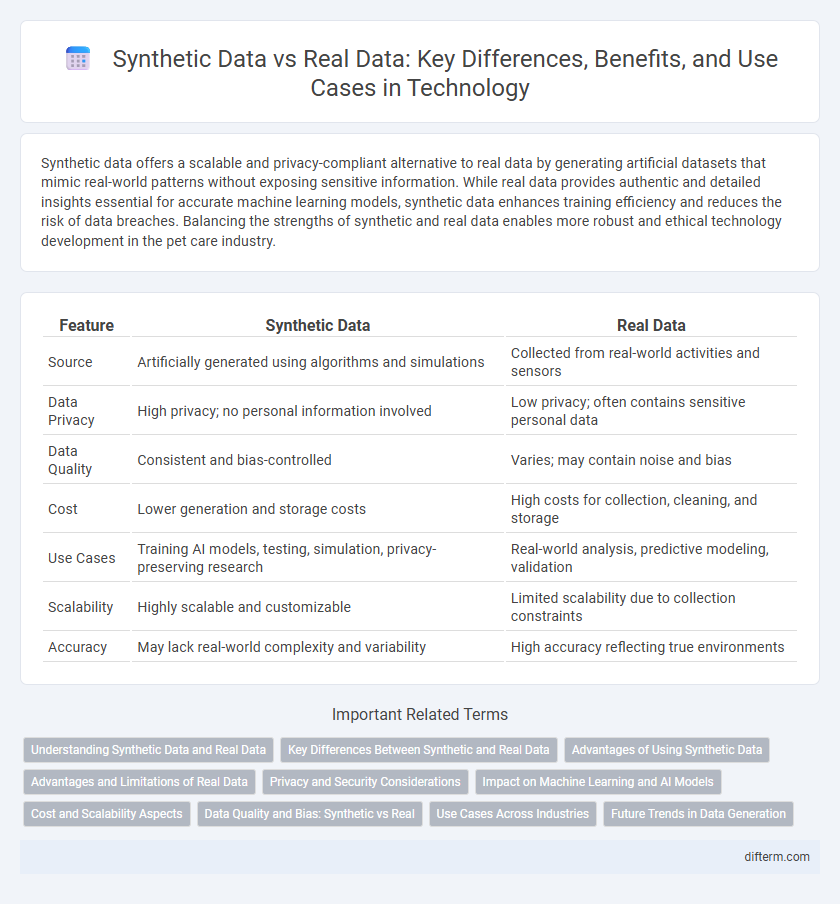Synthetic data offers a scalable and privacy-compliant alternative to real data by generating artificial datasets that mimic real-world patterns without exposing sensitive information. While real data provides authentic and detailed insights essential for accurate machine learning models, synthetic data enhances training efficiency and reduces the risk of data breaches. Balancing the strengths of synthetic and real data enables more robust and ethical technology development in the pet care industry.
Table of Comparison
| Feature | Synthetic Data | Real Data |
|---|---|---|
| Source | Artificially generated using algorithms and simulations | Collected from real-world activities and sensors |
| Data Privacy | High privacy; no personal information involved | Low privacy; often contains sensitive personal data |
| Data Quality | Consistent and bias-controlled | Varies; may contain noise and bias |
| Cost | Lower generation and storage costs | High costs for collection, cleaning, and storage |
| Use Cases | Training AI models, testing, simulation, privacy-preserving research | Real-world analysis, predictive modeling, validation |
| Scalability | Highly scalable and customizable | Limited scalability due to collection constraints |
| Accuracy | May lack real-world complexity and variability | High accuracy reflecting true environments |
Understanding Synthetic Data and Real Data
Synthetic data is artificially generated information created using algorithms and simulations, often employed to augment or replace real data in machine learning and AI model training. Real data consists of actual observations or measurements collected from real-world processes, providing authentic insights but often limited by privacy concerns and availability constraints. Understanding the distinctions between synthetic and real data helps optimize data strategy, balancing cost, scalability, and accuracy in technological applications.
Key Differences Between Synthetic and Real Data
Synthetic data is artificially generated using algorithms and models, ensuring privacy and scalability, while real data is collected from actual events or measurements, reflecting true-world variability and noise. Synthetic data enables controlled experiments and data augmentation without privacy concerns, whereas real data offers authentic insights critical for accurate model validation. Key differences include data origin, privacy considerations, and representativeness, impacting their suitability for various machine learning applications.
Advantages of Using Synthetic Data
Synthetic data offers enhanced privacy protection by generating artificial datasets that mimic real data patterns without exposing sensitive information. It accelerates machine learning model training by providing abundant, diverse, and balanced data, reducing biases found in limited real datasets. Moreover, synthetic data enables testing and development in scenarios where real data is scarce, costly, or difficult to obtain.
Advantages and Limitations of Real Data
Real data offers unparalleled accuracy and relevance, reflecting true user behaviors and scenarios crucial for training robust machine learning models. However, it often faces challenges related to privacy concerns, data scarcity, and costly collection processes. Despite these limitations, real data remains essential for validating synthetic datasets and ensuring model generalizability in real-world applications.
Privacy and Security Considerations
Synthetic data enhances privacy by generating artificial datasets that mimic real-world information without exposing sensitive personal details, reducing risks of data breaches and compliance violations. Real data, while rich and accurate, poses significant security challenges as it contains actual user information vulnerable to unauthorized access and misuse. Employing synthetic data enables organizations to comply with stringent data protection regulations like GDPR and CCPA while maintaining robust security postures during data analysis and machine learning processes.
Impact on Machine Learning and AI Models
Synthetic data enables the training of machine learning and AI models by providing large, diverse datasets that mitigate privacy concerns and reduce biases inherent in real data. Real data offers authentic patterns crucial for model accuracy but often comes with limitations like scarcity, noise, and ethical restrictions. Balancing synthetic and real data enhances model robustness, generalization, and performance in complex AI applications.
Cost and Scalability Aspects
Synthetic data significantly reduces costs associated with data collection, labeling, and privacy compliance compared to real data. It offers unparalleled scalability by enabling the generation of vast datasets on-demand, supporting rapid model training and testing without physical constraints. Real data, while inherently authentic, often incurs higher expenses and faces challenges in scaling due to acquisition, storage, and legal limitations.
Data Quality and Bias: Synthetic vs Real
Synthetic data offers controlled variability and reduced privacy risks but may lack the nuanced complexity and unpredictable patterns inherent in real data, which can impact data quality. Real data captures authentic distributions and subtle correlations vital for training robust AI models, yet it often carries biases reflecting historical and societal inequalities. Balancing synthetic data generation techniques with real data validation enhances model fairness and performance by mitigating bias and improving data quality.
Use Cases Across Industries
Synthetic data enables robust machine learning model training in industries like healthcare, where patient privacy limits access to real data, and finance, where it helps detect fraud without exposing sensitive information. Autonomous vehicle development relies on synthetic data to simulate rare driving scenarios that real-world data rarely captures, enhancing safety and performance. Retail and e-commerce sectors use synthetic data to optimize customer behavior analysis and personalized marketing while avoiding data privacy risks associated with real consumer data.
Future Trends in Data Generation
Synthetic data offers scalable and privacy-compliant alternatives to real datasets for AI training, accelerating innovation in machine learning models. Advanced generative algorithms and simulation technologies are enhancing the realism and diversity of synthetic data, enabling more robust and unbiased analytics. Future trends indicate a growing integration of synthetic data with real data, optimizing data augmentation and addressing the limitations of data scarcity in emerging AI applications.
synthetic data vs real data Infographic

 difterm.com
difterm.com